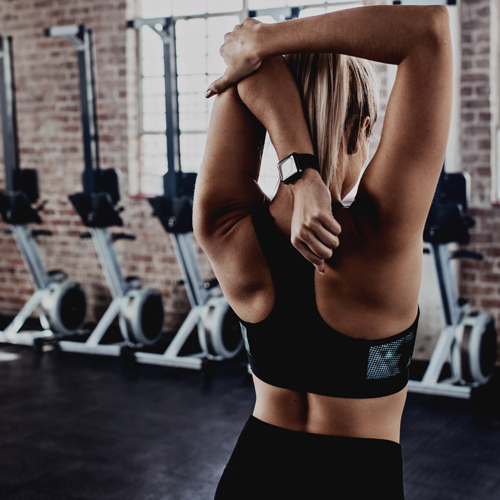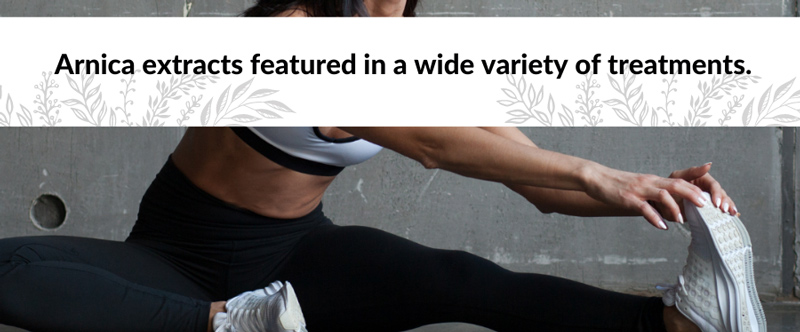
Whether it’s a no-contact bruise from going too hard on leg day, or soreness from a particularly intense practice session, an active lifestyle is almost always synonymous with bruising and pain. For several years now, the zeitgeist has been obsessed with arnica for bruising and pain relief.
We know that exercise-induced injuries and bruises can prolong your downtime and really set back your fitness goals. We love performance skincare, and if arnica lotion is a natural way to ease pain and get you active again, we’re into it.
The question is, does arnica really soothe bruising?
To answer this, we’ll explore:
- Why arnica is just as effective as ibuprofen
- How arnica facilities blood flow to help with bruising
- Why you shouldn’t DIY arnica
Table of Contents
- What Is Arnica?
- What Are the Benefits of Using Arnica?
- How to Use Arnica for Bruising
- How Arnica Eases Pain and Bruising
- Is DIY Arnica Cream Worth the Effort?
- Ease Your Aches and Bruises With Arnica
- Frequently Asked Questions
What Is Arnica?
Arnica is a perennial, daisy-look-a-like herb native to the mountainous regions of Europe. Its dried blooms have been in use for hundreds of years to ease bruising, pain, and swelling associated with injuries and arthritis.
Despite its wide historical use, ranging from heart tonics to gingivitis treatment, arnica is used as a strictly topical ingredient because of its toxicity when taken orally. However, some exceptions do exist and include homeopathic and anthroposophic uses, which use arnica in a highly diluted form.
Regarding the ease of pain, one study found topical arnica to be as effective as ibuprofen in reducing pain intensity and bringing back hand function in people with arthritis.
Out of the 204 patients in the same study, six patients in the ibuprofen group experienced side effects, compared to only five in the arnica group.
It’s worth noting that topical arnica has fewer and milder potential side effects than ibuprofen.
In the table below, we compare the potential side effects of topically applied arnica for bruising versus ibuprofen.
| Topical Arnica 5% Concentration | Topical Ibuprofen 5% Concentration |
|
|
Fun Fact: Arnica montana, the European species of the plant, was so popular and over-harvested in the past century that it joined the endangered plant species list.
Thanks to its special protection status under the Convention on International Trade in Endangered Species of Wild Fauna and Flora (CITES), arnica is no longer gathered from the wild in alpine regions (Austria, France, Germany, Italy, Liechtenstein, Monaco, Slovenia and Switzerland).
Efforts have been made to grow it commercially in Germany, France, Italy, Switzerland, and Chile in order to protect the wild arnica population. The North American and South American varieties of arnica are also being studied.
What Are the Benefits of Using Arnica?
Now let’s get to the meat of it. Arnica has many active benefits, including its antibacterial, antifungal, antiseptic, anti-inflammatory, and pain-relieving properties.
Within 3–4 days of using arnica for bruising, you may experience a reduction in:
- Swelling at the site of a closed-skin injury or overstretched muscles
- Bruises or skin discoloration due to injury
- Pain caused by torn or stretched ligaments (sprains)
- Muscle pain brought on by overuse or minor injuries
- Inflammation, pain, and swelling of joints (for instance, in cases of osteoarthritis)
"I tried arnica gel for my bruises. Within two days, the bruises were significantly less dark, and they hurt less. Would highly recommend this product for anyone that needs to minimize the appearance of external bruising."
Now that we have a better understanding of what arnica is and what its benefits are, what’s the most effective way to use it to ease bruising?
How to Use Arnica for Bruising

If you’re looking to reduce bruising, the best time to apply arnica is immediately after the bruise or injury occurs.
Here are some other tips on the effective application of arnica:
- Gently rub arnica cream or gel into the bruised area until fully absorbed, 2–3 times a day.
- Improve circulation by massaging the arnica cream into the bruised area using long and deep strokes. Greater blood flow aids in healing.
- If you want to use the hot and cold compress method, apply the heat or ice pack for 20 minutes beforehand, wait for the skin to resume its normal temperature, then massage the arnica lotion or cream into the bruised area.
- Don’t apply support or compression bandages too tightly while using arnica topically. This will ensure proper blood circulation and a reduction in bruising.
- Monitor your skin carefully and discontinue use if you notice any skin irritation. As with any other skin product, an allergic reaction to arnica cream is possible.
- It’s best to use concentrated medicinal arnica creams only for the recommended period of time, usually 3 weeks. Consult your doctor before using them for a prolonged period.
Expert Tip: A great alternative to restricted medicinal creams with a high arnica concentration is to use a non-greasy, gentle arnica lotion formulated for an active lifestyle, such as the KOYA Arnica & Green Tea Blend.
Its ingredients include arnica for bruising. The green tea, horsetail and ginkgo biloba extracts are powerful antioxidants that help tone and restore the skin.
The Don’ts of Using Arnica
We’ve already talked about the obvious one. Arnica doesn’t belong anywhere near your mouth or inside your body because of its toxicity. Never use it orally or internally.
Similarly, using arnica on a bruise with broken skin or open wounds is unsafe because your body may absorb it.
How Arnica Eases Pain and Bruising
We really believe in having a thorough understanding of our ingredients, so let’s get into the workings of arnica.
Arnica is anti-inflammatory, meaning that it balances out inflammation which generally presents as pain and swelling.
Arnica contains several active compounds, including lactones, flavonoids, terpenoids, phenolic acids, and essential oils. For bruising, we’re interested in the lactones, which are the compounds responsible for arnica’s anti-inflammatory activity.
We’re going to get a little technical here, but we’ll keep it brief and to the point.
The lactones in arnica reduce inflammation and bruising by:
- Blocking the activation of certain proteins that start the inflammation process after an injury occurs
- Curbing the enzymes which trigger inflammation, especially in the joints and cartilage
- Stopping platelet function, which reduces the activity of certain inflammatory enzymes
Arnica may also increase blood flow to the bruised area, which can mimic the effect of anti-inflammatory creams.
Quick recap:
- Bruising and injury of any kind is often accompanied by inflammation.
- Inflammation is part of the healing process, but if it’s not controlled, it can be really painful.
- Using arnica for bruising controls this inflammation process, reducing pain and discoloration.
Is DIY Arnica Cream Worth the Effort?

A quick search for arnica and bruising will yield a DIY recipe or two. Let’s be brutally honest: trying to DIY your own arnica cream is not worth the hassle.
Unless you’re a chemist, or regularly make your own skincare products at home and have an assembly station ready to crank out the cream, you will not enjoy the DIY process.
You would need to buy the raw extracts and oils, put together a sterile cream-making station and hope that you measured the correct ratios to result in a product that soothes the skin, smells pleasant, and feels great.
Just save yourself the headache and use an arnica lotion that’s been formulated using clean, natural ingredients and has a heavenly scent.
Ease Your Aches and Bruises With Arnica
Arnica isn’t the new kid on the block. Modern medicine and cosmetics have just rediscovered one of nature’s secrets. Arnica has eased bruises, aches and injuries for centuries.
The best part is that today you don’t have to go frolicking in the mountains yourself to gather arnica for your skincare. If you’re looking for an arnica lotion that is gentle, non-greasy, and natural, try KOYA Arnica & Green Tea Blend.
Frequently Asked Questions
Who should avoid arnica for bruising?
If you’re allergic or hypersensitive to the aster family of flowering plants, you shouldn’t use arnica. Members of this plant family include daisies, chrysanthemums, marigolds, ragweed, sunflowers and many others.
Do not use arnica products if you’re pregnant or breastfeeding either.
Does arnica interact with other medications?
So far, there are no known interactions between the arnica herb and other medications.
However, arnica may thin the blood and block the clotting action of platelets. Anyone on antiplatelet drugs or blood thinners should avoid using arnica or consult their doctor beforehand.
What is the difference between topical or herbal arnica and homeopathic arnica?
Topical or herbal arnica products in cream, gel or tincture form usually contain 15–25% arnica oil. These concentrations are much higher than homeopathic arnica, which is extremely diluted.
Secondly, studies on the effectiveness of topical arnica have quantifiable, positive results, while current research shows that homeopathic arnica is no better than a placebo.
Share on Facebook:


